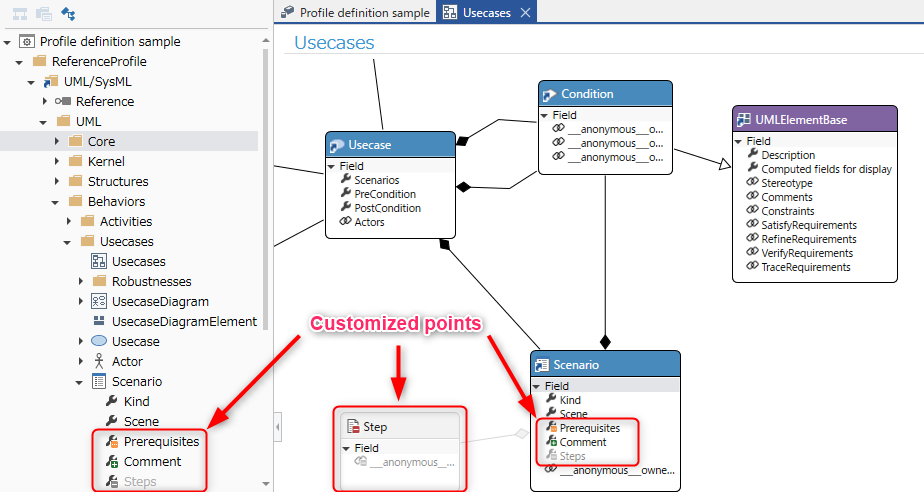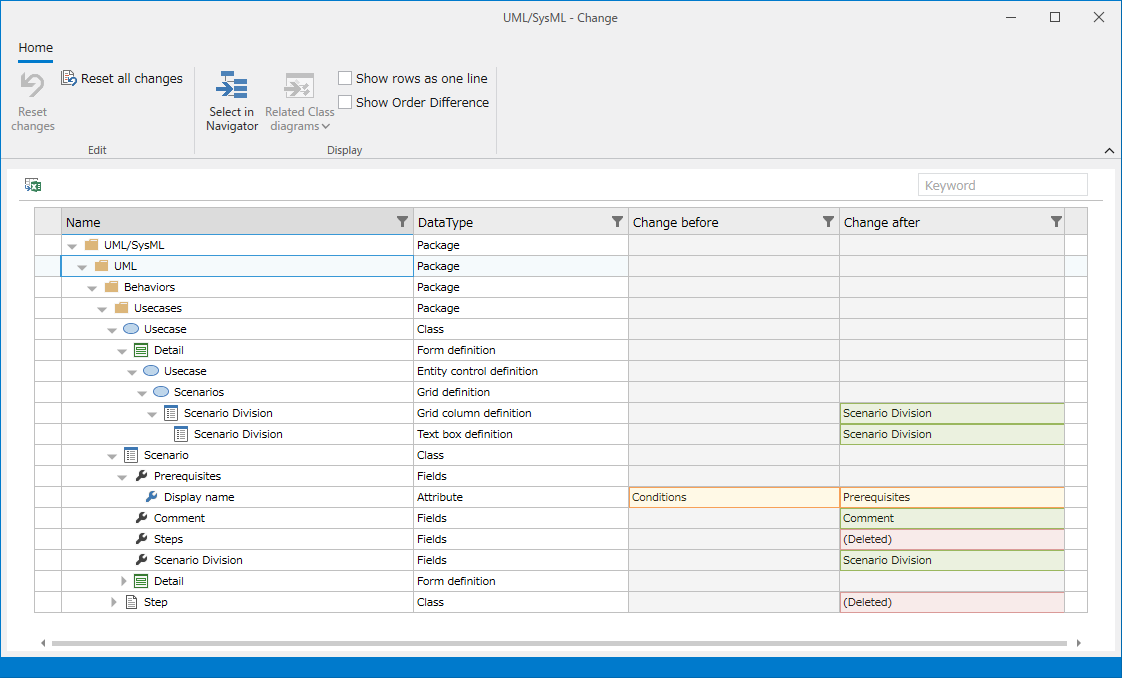Customizing a profile
Overview
In addition to using modularized profiles as is, you can customize profiles to suit the projects in the field. For example, you can absorb differences between projects by matching the names of design items to the names used in the field and selecting and discarding information to be designed.
The following describes how to customize the profile you are using in the following order.
- Customize the profile you are using
- Check the change differences caused by customization
- Cancel changes made by customization
- Restrictions
Customize the profile you are using
By customizing the profile you are using, you can change, add, or disable metamodels and view definitions. For example, you can customize the following:
- Example of metamodel customization
- Delete (disable) classes not used in the project or classes other than the target process
- Change the display name of a class or field to a name familiar to the project
- Add classes and fields to hold project-specific design information
- Example of view definition customization
- Delete (disable) shape definitions not used in ER diagrams and add project-specific shape definitions
- Change the column configuration of the tree grid
- Add project-specific views

- The method of customizing a profile is the same as the method of editing a metamodel or view definition. For customization restrictions, see "Restrictions" below.
- The operations of "delete" and "disable" have the same result for elements of a referenced profile. Either operation disables the element and makes it undefined in the profile. Disabled profile elements can be restored. For details, see "Resetting customizations" below.
- If you check the [Profile] > [Tailoring] > [Show changes] checkbox, you can identify the customized parts with icons on the profile navigator and class diagram.
- If you delete (disable) a metamodel class from a referenced profile, the model corresponding to that class will be deleted. The deleted model will not be restored even if you restore the disabled class.
- If you delete (disable) a view definition or shape definition of a diagram from a referenced profile, the information such as the position, size, and style of the shape on the diagram will be deleted. The information will not be restored even if you restore the disabled view definition or shape definition.
- If you disable a class that inherits from, the inherited class will not be disabled. However, the fields defined in the inherited class will no longer be available.
- If three classes have an inheritance relationship such as
Class A <- Class B <- Class C, disablingClass Bwill result in the same inheritance relationship asClass A <- Class C.
In this case, the fields defined in Class B cannot be used, but the fields defined in Class A can be used as is.
Check the changes made by customization
To check the list of customizations in the referenced profile, follow the steps below.

-
In the Profile Navigator, select the profile reference package or an element under it.
-
To check the list of customizations, do one of the following:
-
Click [Show Change List] from the context menu.
-
Click [Profile] > [Tailoring] > [Change List] from the ribbon.
- The [Changes] window opens, displaying a list of customizations for the selected profile reference package.
-
If you check the [Show Order Differences] checkbox in the [Changes] window, the [Order Differences] column will be displayed and you can check the order changes.
-
If you check the [Profile] > [Tailoring] > [Show Changes] checkbox, you can identify the customized parts by icons on the profile navigator and class diagram.
Resetting changes due to customizations
To revert changes due to profile customizations, follow the procedure below.
- As in the previous "Checking the change differences due to customizations" (#list-customization), open the [Changes] window and display the customizations.
- Select the line for which you want to undo the change from the list of changes, and click [Home] > [Edit] > [Undo Changes] on the ribbon.
- To undo all changes, click [Home] > [Edit] > [Undo All Changes] on the ribbon.
-
About added elements
The added elements remain even if you undo all changes. To delete the added elements, delete them in one of the following ways. -
Click [Home] > [View] > [Select in Navigator] on the ribbon to delete the corresponding element from the profile navigator.
-
Click [Home] > [View] > [Related Class Diagram] on the ribbon to delete the corresponding element from the class diagram.
-
About disabled dependent elements
The elements that are displayed as [(Deleted)] in the [Before] column in the list of changes are the disabled element and its dependent elements such as child elements that have been disabled accordingly. If a disabled dependent element is selected, you cannot undo the change with the Undo Changes button on the ribbon. To undo the change, select the disabled element itself in the Profile Navigator and select Undo Changes from the context menu. The icon of the disabled element is marked with a red mark like this:
- If the [Profile] > [Tailoring] > [Show Changes] check box is selected, you can undo the customization changes from the Profile Navigator or Class Diagram. To undo the change, right-click the customized element and select Undo Changes from the context menu.
Limitations
- You can change the [Display Name] of the referenced profile element, but not the [Name].
- You cannot move the referenced profile element to a different parent.
- You can disable the enumeration values defined in an enumeration type individually, but you cannot disable the last one.